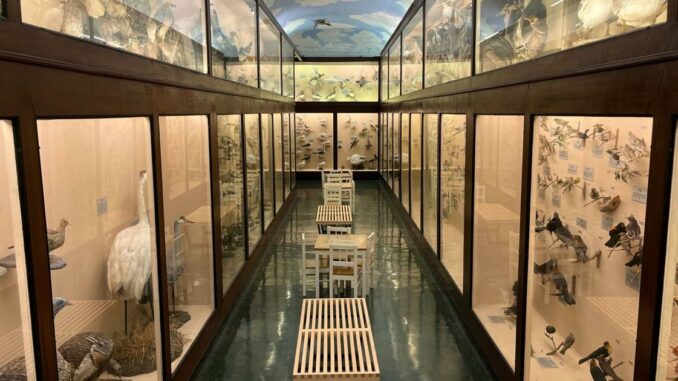
One bird has a long and slender beak, perfect to pluck an unsuspecting bug off a twig. Another, on display above the first, could crack acorns open with its short and stubby beak.
Studio arts freshmen Remy Cantrelle and Ayla Hilaire recently sat in the LSU Museum of Natural Science’s Lowery Hall of Birds, a narrow passage filled from ceiling to floor with taxidermy birds. Pen and paper in hand, they observed the subtle differences of wings and beaks among species, then began sketching. Soft scribbling was the only sound in the otherwise empty museum.
A new crosswalk with a creative twist has been painted on LSU’s campus to improve pedestrian safety for students.
The Lowery Hall of Birds was constructed in 1952 and houses around 550 birds, all of which have appeared in Louisiana at least once. Named after the museum’s founder and first director, George Lowery, the hall is only a small portion of the museum’s massive ornithology department.
The museum’s full collection comprises over 230,000 bird skins, skeletons and stomach-content samples, making it the nation’s third largest university-based bird collection. Only Harvard and the University of Michigan outrank it.
But many staff members feel the museum is overlooked. Museum curators said the university doesn’t seem to care about the collection, and having hundreds of thousands of bird samples hasn’t changed that.
“Museums are often viewed as cabinets of curiosity for things of the past, and for that reason they sometimes get viewed as expendable,” said Nicholas Mason, the ornithology collection’s curator.
He believes LSU’s museum-apathy can be clearly seen in a lack of sufficient funding. His job is to handle the department’s long-term plans and, according to him, most of the work is just securing funding for the future.
“One thing to consider about funding is that we have been fortunate enough to still get it, but there’s lots of instances of museums that have closed,” said Mason.
He said the museum’s pool of funds has three main components: money budgeted by the state/university, money made through public fundraising, and money granted by the federal government. State money is in no way the most important or impactful, according to Mason.
Tammie Jackson, the museum’s business manager, echoed the sentiment. She said the state-allocated funds are only enough to pay the museum staff and rarely go toward research or maintenance.
Jackson said on average, the museum receives about $220,000 from the state in a year. She said that while the number has never gone up, she was thankful it hasn’t gone down either.

Paragraph by paragraph, word by word, Faculty Senate’s ad hoc committee on information technology nears a month since it first began scrutiniz…
“In my 17 years here, they haven’t taken any funds from us yet,” she said.
The museum maintains its staff because of state funding, but to expand collections and perform research, Mason said it looks elsewhere.
“The overwhelming majority of funding we apply for is federal grants,” he said.
Mason credited these large sums of grant money to the world-renowned quality of research performed by the museum. He said LSU’s scientific output and its value are impossible to overstate.
“Forty-odd species have been described by LSU ornithologists,” he said. “If you look at other museums, a really large proportion of their curators and people that work in them, both in the U.S. and around the world, either did their Ph.-D., master’s or undergrad here at LSU.”
The museum’s graduate assistants are part of its lifeline. According to Mason, funding limitations make it impossible to expand the staff, so five collections managers and nine graduate assistants handle most of the routine work that keeps the museum functioning.
Many of these tasks fall under the umbrella of collection maintenance. Dead animals tend to attract bugs and worms. Dead animals in a prestigious scientific collection are no exception. Mason said graduate assistants are the line of defense between 200,000 scientific specimens and 200,000 units of bug food.
Specimens are stored in filing cabinet-like containers containing anywhere from 20 to 1,000 birds depending on their size. Mason estimated one of the museum’s back rooms to contain about 12,000 birds and 30 cabinets.
Each cabinet along with every bird in it must be thoroughly inspected once every one to two years for contaminants like larva, bug feces and maggots. Mason said graduate assistants often perform these inspections because hiring personnel to perform inspections and other similar duties is out of the museum’s financial reach.
Mason believes tasking grad students with time-consuming inspections on top of their demanding master’s course work is unreasonable and stretches them too thin. One walk through the specimen storage rooms legitimizes Mason’s concerns.

All cabinets have an inspection log used to keep track of each time the container has been checked for contaminants. A log with 2017 or 2018 as its most recent inspection is not a rare sight. Mason remarked on one cabinet that had not been inspected in over 10 years.
The parts of the museum visible to the public maintain a similar and at times more pronounced run-down quality. Most exhibits were built over 40 years ago, and they often wear their age.
Because the museum already struggles to maintain its internal collection, Jackson said maintaining the public displays isn’t even in the conversation. She said the exhibits are mostly left to their own devices, so any wear and tear incurred over time is unlikely to be fixed.
“The exhibits don’t get touched,” she said.
Many students still find a bit of shabby charm in the decades-old displays. Hilaire appreciated the care put into the Hall of Birds’ presentation and said it stood the test of time.
“They have these little clouds painted up there with taxidermy birds hanging from them,” she said.
More than anything, she enjoys the hall as an artistic resource. She said drawing animals is often hard because of how much they move around, but dead animals have a talent for sitting still. Hilaire and Cantrelle said they often sit in the museum and sketch for hours while marveling at the variety of species.
There’s always room for improvement though, and Cantrelle had only one wish for the museum as it moves forward.
“I thought there’d be a peacock,” she said.

Leave a Reply